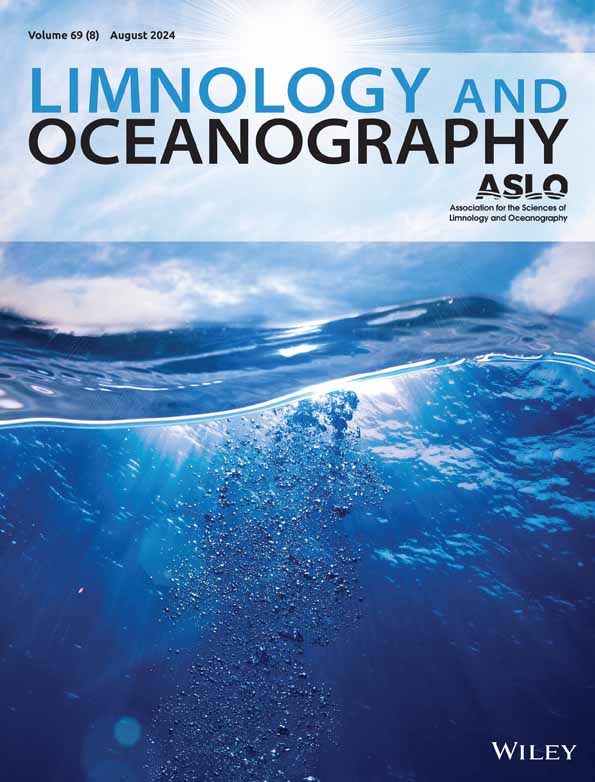Gross oxygen production and microbial community respiration in the oligotrophic ocean
IF 3.8
1区 地球科学
Q1 LIMNOLOGY
引用次数: 0
Abstract
Uncertainties in the temporal and spatial patterns of marine primary production and respiration limit our understanding of the ocean carbon (C) cycle and our ability to predict its response to environmental changes. Here we present a comprehensive time‐series analysis of plankton metabolism at the Hawaii Ocean Time‐series program site, Station ALOHA, in the North Pacific Subtropical Gyre. Vertical profiles of gross oxygen production (GOP) and community respiration (CR) were quantified using the寡营养海洋的氧气总产量和微生物群落呼吸作用
海洋初级生产和呼吸作用时空模式的不确定性限制了我们对海洋碳(C)循环的理解以及预测其对环境变化的反应的能力。在此,我们对北太平洋亚热带环流中的夏威夷海洋时间序列计划站点 ALOHA 站的浮游生物新陈代谢进行了全面的时间序列分析。在黎明到黄昏的原地培养过程中,我们采用 18O 标记水法对总产氧量(GOP)和群落呼吸量(CR)的垂直分布以及氧气与氩气比率的净变化进行了量化。同时还测定了 14C 碳酸氢盐同化速率(基于 14C 的初级生产 [14C-PP])。在观测期间(2015 年 4 月至 2020 年 7 月),透光层深度整合(0-125 米)的 GOP 和 14C-PP 分别为 35 至 134 mmol O2 m-2 d-1 和 18 至 75 mmol C m-2 d-1,而 CR 为 37 至 187 mmol O2 m-2 d-1。所有生物速率都随深度和季节而变化,其中在透光层下部(75-125 米)的季节性最为明显。GOP 与 14C-PP 的年平均比率为 1.7 ± 0.1 mol O2 (mol C)-1。以往的研究表明,随着深度的增加,GOP 和 14C-PP 趋于一致,而我们发现 GOP 与 14C-PP 的比率在垂直方向上的下降并不那么明显,在较低的透光带,GOP 比 14C-PP 高出 50%或更多。CR 的变异性比 GOP 的变异性要高,这也是二者平衡变异性的主要原因。
本文章由计算机程序翻译,如有差异,请以英文原文为准。
求助全文
约1分钟内获得全文
求助全文
来源期刊

Limnology and Oceanography
地学-海洋学
CiteScore
8.80
自引率
6.70%
发文量
254
审稿时长
3 months
期刊介绍:
Limnology and Oceanography (L&O; print ISSN 0024-3590, online ISSN 1939-5590) publishes original articles, including scholarly reviews, about all aspects of limnology and oceanography. The journal''s unifying theme is the understanding of aquatic systems. Submissions are judged on the originality of their data, interpretations, and ideas, and on the degree to which they can be generalized beyond the particular aquatic system examined. Laboratory and modeling studies must demonstrate relevance to field environments; typically this means that they are bolstered by substantial "real-world" data. Few purely theoretical or purely empirical papers are accepted for review.
 求助内容:
求助内容: 应助结果提醒方式:
应助结果提醒方式:


